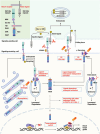Notch signaling in diabetic kidney disease: recent progress
- PMID: 40822939
- PMCID: PMC12350112
- DOI: 10.3389/fendo.2025.1537769
Notch signaling in diabetic kidney disease: recent progress
Abstract
Diabetic kidney disease (DKD) is one of the most serious complications of diabetes mellitus (DM) and the main cause of end-stage renal disease (ESRD). The number of affected patients is increasing annually worldwide. Therefore, it is necessary to establish new strategies to treat DKD and improve prognosis. The Notch signaling pathway is involved in multiple mechanisms in DKD, including glomerular endothelial dysfunction, filtration barrier damage, podocyte EMT and dedifferentiation, tubulointerstitial fibrosis, proximal tubule cell dedifferentiation, macrophage polarization, etc. In addition, Notch signaling interacts with other pathways involved in DKD progression, such as TGF-β, Wnt/β-catenin, mTOR, AMPK, autophagy, etc. Therefore, new ideas for the future treatment of DKD may be provided through clarification of the role of the Notch signaling pathway and development of novel drugs.
Keywords: Notch signaling; diabetic kidney disease; podocyte; renal fibrosis; therapy.
Copyright © 2025 Wang, Tu, Long, Li, He and Wu.
Conflict of interest statement
The authors declare that the research was conducted in the absence of any commercial or financial relationships that could be construed as a potential conflict of interest.
Figures



Similar articles
-
Podocyte NPRC Deficiency Attenuates Glomerular Fibrosis in Diabetic Mice.Circ Res. 2025 Aug;137(4):e88-e105. doi: 10.1161/CIRCRESAHA.124.325702. Epub 2025 Jun 25. Circ Res. 2025. PMID: 40557490
-
Qing-Re-Xiao-Zheng-(Yi-Qi) formula attenuates the renal podocyte ferroptosis in diabetic kidney disease through AMPK pathway.J Ethnopharmacol. 2025 Jul 24;351:120157. doi: 10.1016/j.jep.2025.120157. Epub 2025 Jun 16. J Ethnopharmacol. 2025. PMID: 40532799
-
DNMT3B aggravated renal fibrosis in diabetic kidney disease via activating Wnt/β-catenin signaling pathway.Sci Rep. 2025 Jul 1;15(1):21070. doi: 10.1038/s41598-025-06713-3. Sci Rep. 2025. PMID: 40595027 Free PMC article.
-
Chinese herbal medicine and its active compounds in attenuating renal injury via regulating autophagy in diabetic kidney disease.Front Endocrinol (Lausanne). 2023 Mar 3;14:1142805. doi: 10.3389/fendo.2023.1142805. eCollection 2023. Front Endocrinol (Lausanne). 2023. PMID: 36942026 Free PMC article.
-
Multidisciplinary management of diabetic kidney disease: a systematic review and meta-analysis.JBI Database System Rev Implement Rep. 2016 Jul;14(7):169-207. doi: 10.11124/JBISRIR-2016-003011. JBI Database System Rev Implement Rep. 2016. PMID: 27532796
References
-
- Sun H, Saeedi P, Karuranga S, Pinkepank M, Ogurtsova K, Duncan BB, et al. Idf diabetes atlas: global, regional and country-level diabetes prevalence estimates for 2021 and projections for 2045. Diabetes Res Clin Pract. (2022) 183:109119. doi: 10.1016/j.diabres.2021.109119, PMID: - DOI - PMC - PubMed
Publication types
MeSH terms
Substances
LinkOut - more resources
Full Text Sources
Medical
Miscellaneous

